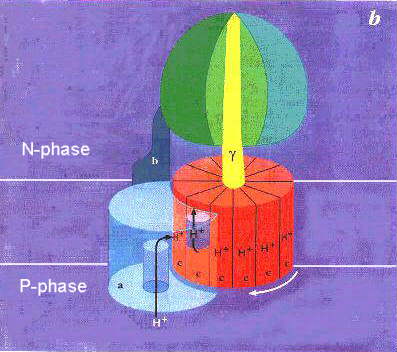I am familiar with the structure and function of ATP synthase, but one small detail doesn't seem to make sense. It also happens to be a detail that seems very hard to express.
Depending on the organism, there can be from 10 to 14 c-subunits in the c-ring of ATP synthase. For practicality/consistency's sake, let's assume 10.
Every c-subunit is protonated (from the cytoplasmic side of the mitochondrion) and rotated almost 360 degrees within the lipid membrane before it is ultimately deprotonated, which releases a proton into the matrix. Thus, since the c-ring is 10 subunits big (in this case), 10 protons are being introduced to the matrix every 360 degree turn, which mean that 1 proton = a 36 degree turn.
These protons allow for the gamma-subunit to be turned at the inside of the hexamer (of 3 alpha-subunits and 3 catalytic beta-subunits) found below the rotor. The b-subunits are thus located 120 degrees apart. Every 120 degrees precisely, that beta-subunit changes shape, dictated by the rotation of the gamma-subunit, and enters one of the three states that ultimately catalyze one ATP from ADP and inorganic phosphate (since only one of the three states actually forms ATP). Since the gamma-subunit catalyses the formation of 1 ATP every 120 degrees, a full 360 degree rotation would yield 3 ATPs.
This is where things go awry in my mind. Within 360 degrees, 10 protons and 3 ATPs are made. Thus, that makes (10/3) protons per ATP, or 3.33 protons/ATP. When the gamma-subunit receives a proton, it rotates 36 degrees, but ATP formation only happens at precisely 120 degrees, and the only common interval between 36 and 120 is 360 (when 3 as opposed to 1 ATPs are made)!
EDIT: The gamma-subunit must rotate in exactly 120 degree increments, because we observe it do so, as shown here.
More detailed analysis in the presence of lower concentrations of ATP revealed that the γ subunit rotates in 120-degree increments, with each step corresponding to the hydrolysis of a single ATP molecule.
Logically, this shouldn't happen though, since the closest increments of 36 to 120 degrees are 108 and 144.
To summarize: How can 3.33 protons ultimately synthesize one, and only one ATP, knowing that a literal third of a proton doesn't exist (excluding quarks) and that increments of 36 degrees can never add up to exactly 120 degrees?
References
- “A Proton Gradient Powers the Synthesis of ATP - Biochemistry - NCBI Bookshelf”, n.d. http://www.ncbi.nlm.nih.gov/books/NBK22388/.

 (
(